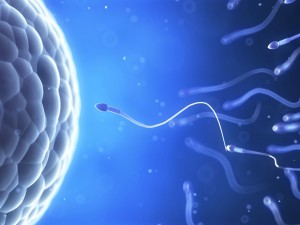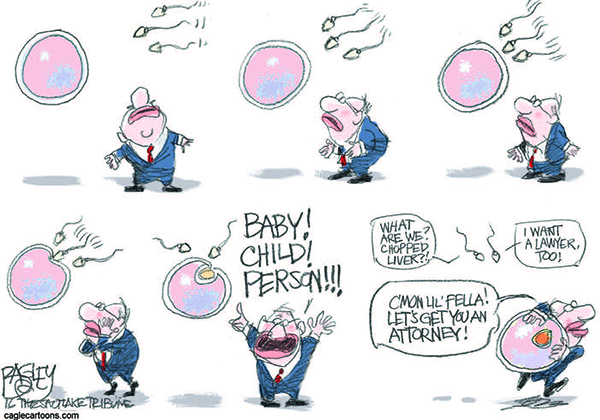The Sanctity of Human Life Act Politicians Playing God

A group of thirty-one Republican US congressmen (yes, all men, as of this writing) have signed on as cosponsors of a bill to declare that human life “begins with fertilization…at which time every human being shall have all the legal and constitutional attributes and privileges of personhood.” The bill, H.R. 586, has been titled the “Sanctity of Human Life Act” (SHLA).
Such “personhood bills” are nearly always religiously driven and have a primary (though unstated) goal of making virtually all abortions illegal. And while personhood bills typically fail, we must acknowledge that we are in atypical times. The Trump administration endorses religious right causes and rhetoric, and the Supreme Court has seated a new justice known to be weak on church-state separation. Threats to reproductive rights must thus be taken seriously.
SHLA asserts that “the right to life guaranteed by the Constitution” is vested in each human being and is “the most fundamental right of a person” that Congress has authority to protect.
This sounds simple and even noble, but SHLA is harmful and astonishingly sweeping in its impacts. There are several problems with its all-embracing absolutism. It does not, for instance, accommodate any special-circumstance exceptions, not even the widely accepted one of allowing an abortion to save a mother’s life. It misinterprets the Fourteenth Amendment to the Constitution, which does not “guarantee a right to life” but says a person cannot be deprived of life “without due process of law.” SHLA would outlaw some popular birth control methods (e.g., an IUD that prevents a fertilized egg from implanting in the uterus). It would open an unfathomable conundrum as to the fate of excess embryos—which some estimates put at a million or more—created with the goal of aiding pregnancies immediately or preserving such potential for later in the event a prospective future parent became infertile.
But perhaps the most contemptible aspect of SHLA is that it represents politicians playing God, arrogantly insistent on defining a debatable concept like personhood by their perspective only. It presumes congressional laymen possess sufficient critical knowledge of the deep and nuanced complexities of prenatal life, when the fact is that religious, philosophical, and legal authorities far more studied on the topic have had difficulty with personhood definitions throughout history.

caglecartoons.com
CENTURIES OF UNCERTAINTY
Not even people who are typically looked to as “God experts” offer an unqualified definition. Take as one example Saint Augustine, a prominent thinker of the early church, some of whose teachings are revered to this day, one being the concept of original sin. He made a distinction between embryo inanimatus (not yet endowed with a soul) and embryo animatus (having a soul), using the ensoulment distinction that was often employed to define personhood. But Augustine said human powers cannot determine the point during fetal development when the ensoulment occurs, and he concluded, “When a thing obscure in itself defeats our capacity and nothing in scripture comes to our aid, it is not safe for humans to presume they can pronounce on it.”
According to the Catholic Education Resource Center, Saint Thomas Aquinas, another respected church father, held that ensoulment occurred sometime after the instant of embryo creation, allowing the embryo to first develop and become “apt” to receive the soul from God. The Resource Center states: “There has never been a unanimous tradition on this point” of the precise timing of ensoulment, and “it would be incorrect to conclude that the church teaches that zygotes or other early-stage embryos are persons.”
Under English common law there was a general consensus that a “person” came into being after “quickening”—the first recognizable movement of the fetus in utero (approximately the sixteenth to eighteenth week of pregnancy)—and abortion was not an indictable offense. English statutory law later encompassed a similar quickening distinction, making it a felony to end “the life of a child capable of being born alive,” with an exception to preserve the life of the mother. Some forty years later, Parliament enacted a new abortion law allowing for several exceptions in which abortion could legally be performed, including preserving the mental health of the mother.
American abortion laws initially followed English common law. Not until after the Civil War did legislation frequently start replacing common law, and most acts dealt severely with abortion after quickening but were more lenient pre-quickening. Exceptions to save the mother’s life were common. In the later 1800s and on into the mid-twentieth century, anti-abortion laws became more strict but most often made an exception to save the mother’s life.
The American Medical Association initially denounced abortion in the 1850s, but a century later approved exceptions not only to save the mother’s life but also in circumstances when a child would be born with “incapacitating physical deformity or mental deficiency” or if a pregnancy had resulted from forcible rape or incest.
NO RELIGIOUS UNANIMITY TODAY
The lack of unanimity on abortion and personhood continues in contemporary positions of major religions. According to the Pew Research Center, five religious denominations support abortion rights with few or no limits (Conservative Judaism, Presbyterian, Reform Judaism, Unitarian Universalist, and United Church of Christ), and another three support rights with some limits (Episcopal, Evangelical Lutheran, and United Methodist). Abortion rights are opposed with few or no exceptions by seven religions or Christian denominations (African Methodist Episcopal, Assemblies of God, Roman Catholicism, Mormonism, Hinduism, Lutheran Missouri Synod, and the Southern Baptist Convention). Islam, Buddhism, National Baptist Convention, and Orthodox Judaism have no clear position according to Pew. The point is that even among those who use a religious basis to judge something like “personhood” protection, judgments vary.
All the more reason why SHLA is a pronouncement beyond the capacity of Congress. It’s one thing for an agent like the Catholic Church to bind its faithful to an absolute regarding when abortion is allowed or not. After all, the faithful can still choose whether or not to follow the rule given. It is quite another for secular legislators, in a religiously pluralistic society embracing varied concepts of “personhood,” to impose a similar absolute on all citizens who will have no such freedom, legally, in choosing whether or not to abide by it.
THE CONSTITUTIONAL CONTEXT
This doesn’t mean it’s a case of anything goes on abortion. Even among those favoring abortion rights, most will agree a fetus (or even a zygote) is a potential human life. But whether it’s a “person” to be given all the rights and protections of born human beings is a different question. In its landmark ruling in Roe v. Wade, the Supreme Court observed that the US Constitution does not define “person” literally and stated: “In nearly all instances, the use of the word is such that it has application only postnatally. None indicates, with any assurance, that it has any possible prenatal application.”
The court concluded that the state’s interest in protecting potential life becomes “compelling” not at conception but at approximately the end of the first trimester—at the point of “viability.” The court specifically said viability is the demarcation because the fetus at this point presumably has the capability to live outside the womb, and there are thus “logical and biological justifications” for the state to assert its interest at this point.
US abortion laws have included goals of protecting the health of the mother, the mother’s rights on procreation, and the state’s interest in protecting prenatal life. SHLA abandons the first two of these. The Supreme Court in Roe said that while the state may assert its interests in prenatal life, limitations on the woman’s rights must be narrowly drawn. There must be balance. The high court noted that a majority of federal and state courts had held state abortion laws unconstitutional “because of vagueness or because of overbreadth and abridgement of rights.” Overbreadth and abridgement of rights are undeniable hallmarks of SHLA.
REASON AND RIGHTS, NOT SPECULATIONS
In achieving its delicate but crucial balance in Roe v. Wade, it is vital to note that the Supreme Court chose “logical and biological justifications,” not philosophical or theological speculation. SHLA gets it backwards. It begins by encoding the latter speculation, something that’s beyond legislative capacity, and then uses it to justify binding the entire citizenry to its legal effects. Because this speculation is for nearly all purposes and intents religiously based—and also selective in what religious traditions it reflects—the bill also runs afoul of the widely accepted First Amendment-based proscription that government may not favor one religion over another nor favor religion over irreligion. SHLA thus also opens the door to an unconstitutional entanglement of church and state.
In evaluating something like SHLA—with its absolutes that are not shared by a majority of citizens, with its religious preferencing, with its non-scientific premises, and with its unconscionable threats to the life and wellbeing of pregnant women—it becomes unmistakable that when legislating, the state should work from a basis of reason and rights as these apply to definitive persons and viable fetuses, not create a new category of embryonic “persons” based on rights-destroying speculation or sectarian tenets.
In other words, the representatives of the state should not be playing God.
